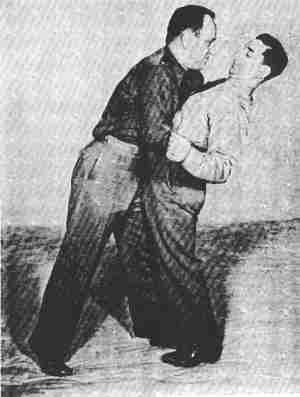
Note: So that they better match the text, the numbers of some figures have been changed from the original.
Overall assessment: Defensively, trainees are being taught to throw before they have learned to fall. This greatly increases the risk of injury. Offensively, trainees have not been taught the importance of posture and center. As a result, most trainees will learn to rely on muscle rather than form when making their escapes, and so have trouble making the moves shown work against stronger or more agile opponents.
17. TWO ESCAPES FROM BEAR HUG. -- Figure 12-1 illustrates the bear hug. Your opponent has grasped you firmly around the waist from the front, and by powerful pressure of his arms is attempting to bend you over backward. [Technical comment: Attacker is already badly off-center, and unless trying to kiss Defender, will normally be standing closer and pulling in rather than simply squeezing with the arms.]

A simple method of causing your opponent to release his hold is illustrated in Figure 12-2. Your fist is closed and your thumb is placed underneath the base of your opponent's nose. Pressure on this very tender spot will cause your opponent to either pull his head backward or release his hold. Your right arm in this case is around your opponent's waist. By pushing with your thumb and pulling in on his waist, you can bear him over backwards. [Technical comment: To escape the thumb, Attacker merely needs turn his head to the side, at which point he is free to bite Defender's hand. Defender also has not dropped his center, meaning that he is easily lifted from the ground, thus negating much of his advantage. Therefore a better defense would be to place an open palm over Attacker's eyes; from there, Defender uses the thumb to "peel" Attacker's nose back, and if Attacker turns his head, Defender simply lets his hand slide down to Attacker's throat for a choke. The defensive posture remains weak, however.]
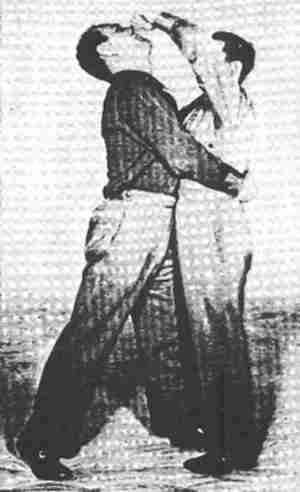
Figure 12-3 illustrates a more effective defense for the same hold. A thumb is brought to the jaw line on either side of your opponent's face and running up the jaw line, brought to bear underneath the ear lobes. Pressure is upward and inward. This is an extremely tender spot and even the strongest of men will be quickly forced to release any hold. [Technical comments: If combined with the obvious (but overlooked) knee to the groin, this is a much better escape than the previous one.]
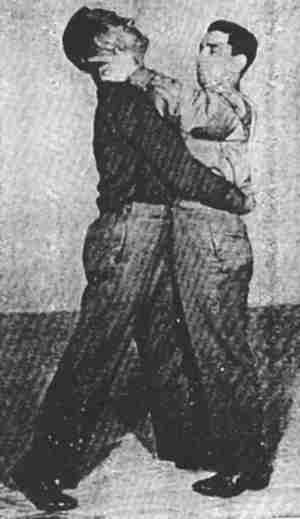
18. ESCAPE FROM FRONT OVERARM BODY HOLD. -- Figure 13-1 illustrates that your opponent has grasped you around the body, including both your arms, so that you cannot use the escapes explained by Figures 12-2 and 12-3.

Your first reaction is to bring your thumbs strongly into your opponent's groin, forcing his hip backward as illustrated in figure 13-2. [Technical comments: The target is NOT the testicles, which are protected by Attacker's stance, but his hip flexors, which are not.]

This leaves a space between your hips and his. Now pivot your hips on your left foot without moving it from the original spot, placing your right foot on the outside of your opponent's right foot, with the toe pointing in the same direction as his. Your right arm slips under his left armpit and grasps him anywhere in back. Your left hand grasps his upper arm, pulling strongly as illustrated in Figure 13-3. [Technical comments: Defender's hips need to be lower to make this throw work; in judo terms, tai otoshi might work better than ogoshi.]

You now strike him strongly in the middle with your hips, at the same time twisting to the left, lifting with your right arm and pulling with your left hand. This will propel your opponent over your hips and to the ground with very little effort, as illustrated in Figure 13-4. [Technical comments: In the photo, Defender is shown standing high and uncentered. As a result, if Attacker relaxes and shifts his own center forward and down before Defender begins the throw, both men are likely to go to the ground together in a jumble, but with Defender on the bottom.
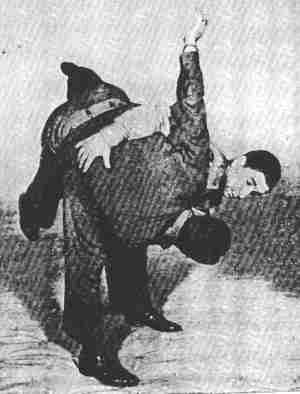
19. ESCAPE FROM CHIN SHOVE. -- A dangerous individual and possibly a powerful one is the one who attempts the attack illustrated in Figure 14-1. He grasps you firmly around the waist with his left hand, attempting to break your neck. [Technical comment: Attacker should be striking with a palm heel rather than pushing, as if Attacker pushes, Defender merely tightens his neck and pushes back from the center. Attacker also should have his right foot farther under Defender's center; as shown, he is off balance and standing too high to present a realistic threat to Defender.]
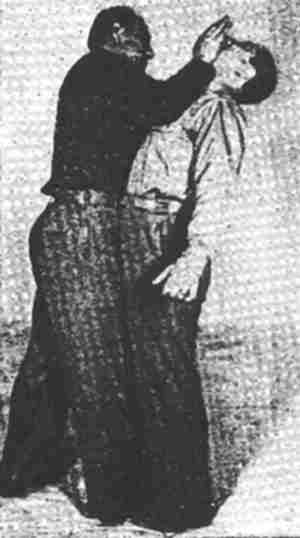
Your initial actions must be simultaneous. Push his right hand upward with your left hand at the same time that you pull your head backward, pushing his hand and arm up in the manner illustrated in Figure 14-2.

Now pivot on your left foot to the left, keeping your left foot in place, placing your right foot on the outside of your opponent's right foot and pointing in the same direction. At the same time, you slip your right arm over his left shoulder and grasp his right shoulder blade as illustrated in Figure 14-3. [Technical comments: From this position, the sensible Attacker raises his right knee into Defender's groin, then strikes Defender in the side of the head using a knife-hand strike.]
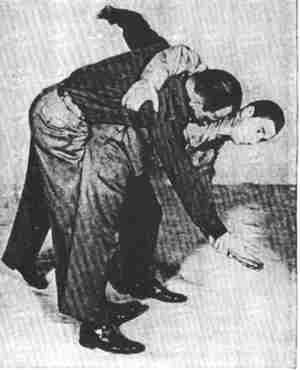
You are now in position to throw him over your hips, as shown in Figure 14-3. [Technical comments: Do not throw him over your hips as shown in Figure 14-3. Defender's knees need to be bent more for a proper tai otoshi, and the grip should be around Attacker's neck rather than his shoulder blade.]
20. ESCAPE FROM FIRST REAR UNDERARM BODY HOLD. -- The attack illustrated in Figure 15-1 shows your opponent behind you, grasping you around the waist and with his head hidden directly behind ours. [Technical comments: Attacker should not be grasping around the waist, but instead the solar plexus; the idea is to do a Heimlich Maneuver using the thumb knuckle. Not only is this harder to escape, it also works better.]
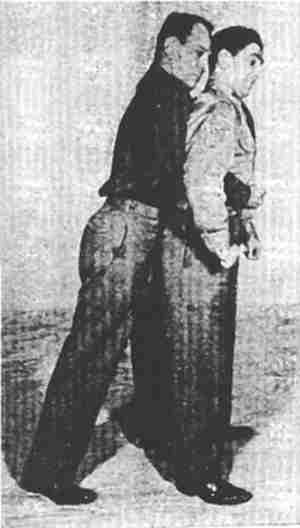
Your immediate reaction is to bring your head backward strongly, striking him in the face with the back of your head as illustrated in Figure 15-2. [Technical comments: This is a good move by Defender, but if Attacker is not off balance to begin with (as shown in Figure 15-1), or is noticeably shorter than Defender, then it does not work. In any case, Defender also must lower his own hips to stabilize his own center of gravity.]
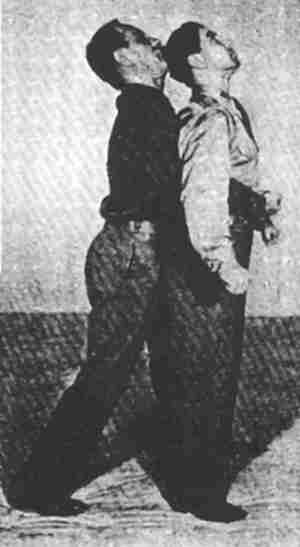
Your next movement is to follow up by bringing both elbows shoulder high and pivoting swiftly from left to right and from right to left as illustrated in Figure 15-3. [Technical comments: The elbow strike shown is good, but Defender's free (left) hand needs to grasp Attacker's hands to keep Attacker from simply letting go and thereby avoiding the blow altogether.]
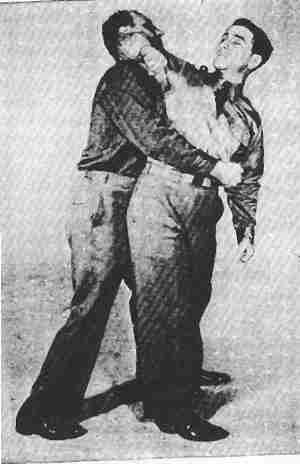
It is impossible for you to miss striking him somewhere in the head by means of this movement. On being struck in this manner, the results are usually devastating to your attacker. [Technical comments: Nothing is impossible.]
21. ESCAPE FROM SECOND REAR UNDERARM BODY HOLD. -- Opponent grasps you as illustrated in Figure 16-1. [Technical comments: As noted above, Attacker should not be leaning forward, and rather than simply grasping around the waist, should be attempting a Heimlich Maneuver.]
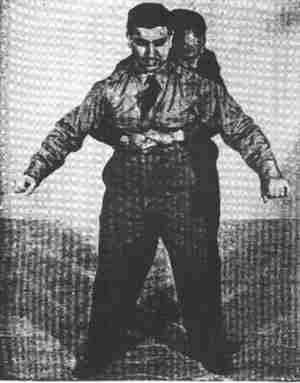
Reach down with your left hand, placing it just above your opponent's left knee. Most of your weight will be borne on your left arm and his left leg as illustrated in Figure 16-2. [Technical comments: Defender should do a better job of maintaining his own center. Also, if Defender can grab the inside of the leg, why not grasp the testicles instead? The pull is done identically either way.]
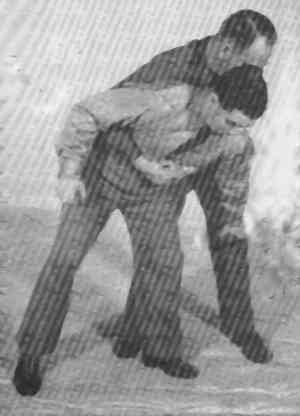
By resting your weight in this manner, you then have a firm basis on which to pivot when you lift both feet from the ground and throw your left leg behind your opponent's right one. As soon as your feet are firmly planted on the ground, you bring your left hand under your opponent's left knee joint and your right hand under your opponent's right knee joint, Figure 16-3. [Technical comments: From this position, Defender should first elbow toward Attacker's face, then instantly drop back for the knee. The idea here is not so much dropping Attacker with the blow (though of course you will take it if you get it!), but to make Attacker pull back, thus giving up his center.]
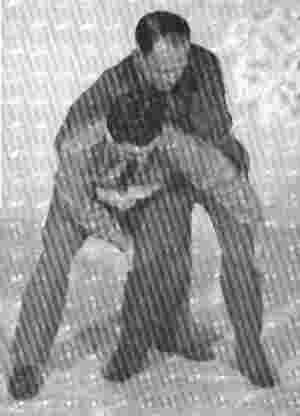
By lifting and leaning backward, you can now easily overbalance your opponent over your left knee. (Figure 16-4.) [Technical comment: Unless you have struck the groin or face, Attacker will hang on, exactly as shown in this picture, and as a result nothing practical will have come from Defender's efforts.]

22. ESCAPE FROM THIRD UNDERARM BODY HOLD. -- Your opponent uses the same grasp around the waist, under the arms from the rear, but this time braces himself by placing one leg between yours and getting his head out of reach of your arms by placing it behind your shoulder blade. (Figure 17-1.) [Technical comments: Normally this is a preamble to Attacker planning a sacrifice back fall in which he reaps up with his left leg and the first thing to hit the floor is the back of Defender's head. A better defense is therefore to step backward with the left foot, thereby forestalling the throw.]
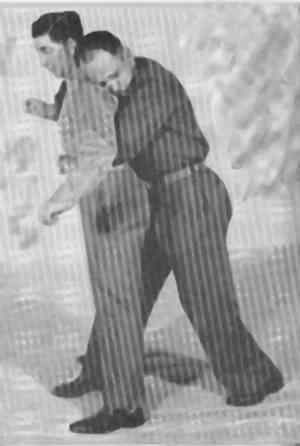
Your immediate action is to bend swiftly from the waist, arms extended, and grasp your opponent's ankle. (Figure 17-2.) [Technical comments: If Attacker were to simultaneously let go and bump then Defender would fall face first on the floor.]
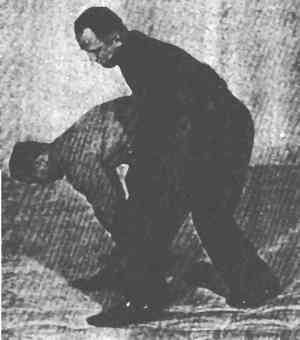
Keeping your grasp on the ankle, you now straighten your body. This brings pressure to bear on your opponent's knee, causing him to release his hold and drop on his back. (Figure 17-3.)
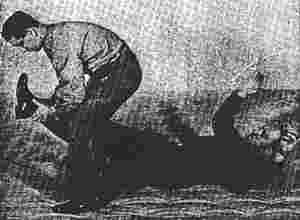
If your opponent should retain his hold, you merely fall backward on top of him, sitting on his midsection with great force. [Technical comments: Defender would do better to sit forward on the knee rather than backward on the stomach, as at this angle Attacker's knee joint is more vulnerable to injury than his stomach.]
23. ESCAPE FROM FOURTH UNDERARM REAR BODY HOLD. -- The hold around the waist from the rear is the same, but this time your opponent clasps his hands together. (Figure 18-1.) [Technical comments: A broken finger may annoy rather than stop a determined Attacker.]

Your initial movement is to use the base of the thumb of either one of your hands, pushing up on one of his index fingers. This will cause him to release his hold. In this illustration, you use your left hand to lift the index finger of his right hand. Immediately the hold is loosened, grasp the back of your opponent's right hand with your right thumb, the fingers of your right hand clasping the palm of his hand around the little finger edge. (Figure 18-2.) [Technical comments: Instead of standing around waiting for something bad to happen, a more sensible Attacker would bump Defender with his belly, thus reestablishing his center, while simultaneously using his free left hand to attack Defender's face or throat.]
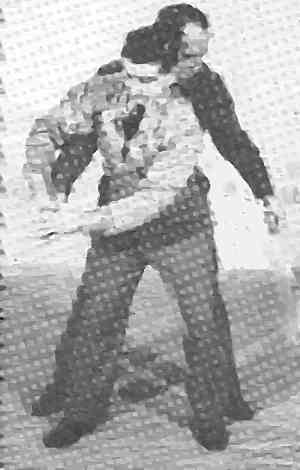
By bringing your elbows close to your midsection and turning to the right, you will cause your opponent to turn his back to you due to the pressure brought on his wrist. During this turn, you will reinforce your original grasp with your right hand with identical grasp with your left. Terminating in the position illustrated in figure 18-3, your elbows are close to your body and you maintain control of your opponent by pressure of your thumbs against the back of his hand. In this position you can march your opponent anywhere you please. [Technical comments: Rather than being marched anywhere Defender pleases, Attacker merely places his thumb against his little finger while stepping forward with his left leg, and thereby rather casually escapes. (For this move to work, Defender MUST be standing much closer to Attacker than shown here.)]
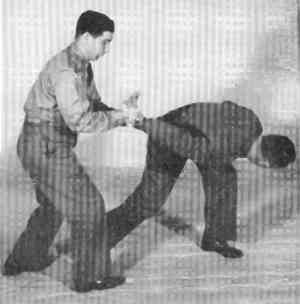
24. ESCAPE FROM FIFTH UNDERARM REAR BODY HOLD. -- When your opponent grasps you around the waist this time, he grasps his own wrist. In this illustration, he has grasped his right wrist with his left hand. Your initial move is to lock his right elbow with your left elbow joint and push on the back of his right hand with your left hand, attempting to force his fingers to touch his wrist. (Figure 19-1.)
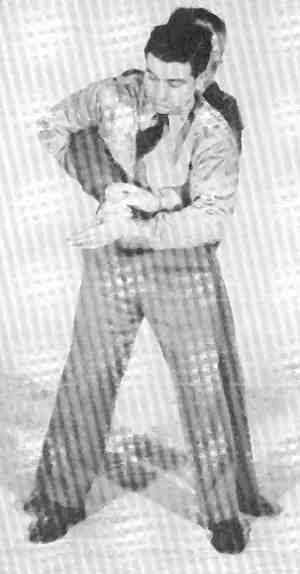
By continuing pressure against the hand, you force your opponent to release his hold and by turning your body, you can take him into several of the come-alongs which will be explained later. (Figure 19-2.) [Technical comments: A better move for Defender is to continue turning counterclockwise, as this should give him a "Figure-4" armlock and perhaps a knee to Attacker's head.]
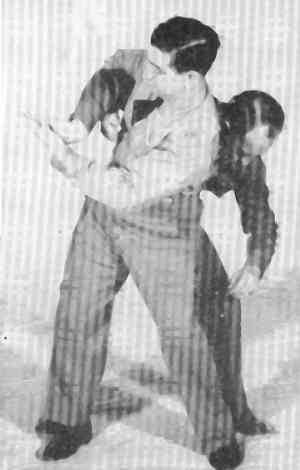
Extreme pressure can cause the dislocation of the wrist, or even a broken wrist.
25. ESCAPE FROM FIRST OVERARM REAR BODY HOLD. -- Your opponent grasps you from the rear and over the arms tightly. (Figure 20-1.)

Your initial movement is to cause him to loosen his hold even momentarily by either stepping on his instep or kicking him in the shin with your heel. The moment you feel the hold loosen, lower your body by bending your knees, and, at the same time, raise your elbows to shoulder height. (Figure 20-2.) [Technical comments: Although this is the right idea, as shown this defense will not work first try on a much stronger Attacker who simultaneously holds his center and pulls. And, of course, stomping on the instep of someone wearing combat boots may not affect him too much. Therefore from this position a military Defender would probably be better advised to try hip bumps rather than shin or instep stomps. In Japanese, the hip bump is known as neko ashi dachi, or cat stance; here the allusion is not to the domestic tabby but to the way that crib-style prostitutes advertised their wares, one leg thrust out of the door. (Think Mae West saying, "Come up and see me sometime," and you've got the idea.)]

From this position swing your elbows backward alternately; swing with the power of the shoulders and midsection, your elbows striking your opponent in either the short ribs or the solar plexus. (Figure 20-3.) [Technical comments: Although an excellent move, once the elbow is delivered, Defender must instantly decide whether he intends to 1) run away; 2) throw Attacker over his shoulder; or 3) turn into Attacker. Due to the direction of the rotation, probably the best bet here would be turning into him. To turn in, keep the spine erect and step across with the left foot, toes up, then rotate from the hips. The right arm then raises into an off-balancing middle block while the left arm hooks into the same area that was just elbowed. After that, Defender would continue applying palm heels to the face, knees to the groin, or leg reaps, as required.]
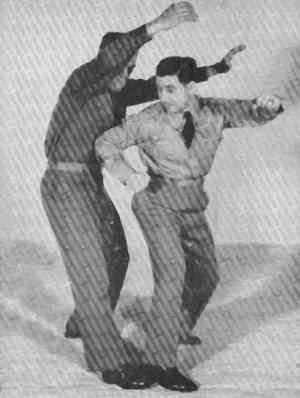
The first blow is usually a knock-out but very seldom can your opponent release his hold entirely before being struck two or three times. [Technical comments: Even by Army standards, the preceding sentence is an oxymoron.]
26. ESCAPE FROM SECOND OVERARM REAR BODY HOLD. -- The original attack by your opponent is again over the arms from the rear. Your initial movement is the same, loosening the grip by means of stepping on the instep or kicking the shins and raising the elbows shoulder high, lowering the body simultaneously by bending the knees. (Figure 21-1.)

Then reach up with your right hand, grasping your opponent's right upper arm just above the elbow, your left hand grasping his right wrist at the same time that you move your right foot on a line with his right foot and on the outside of it. (Figure 21-2.) [Technical comments: Defender needs to bend his right leg more.]
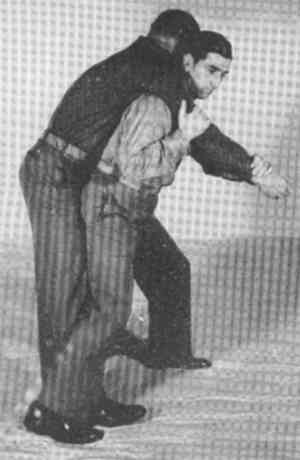
From this position, strike backwards with your hips against his midsection, at the same time bending swiftly from the waist, retaining your grip on his right arm. (Figure 21-3.) [Technical comments: This is a weak throw, relying as it does on a forward bend rather than off-balancing.]
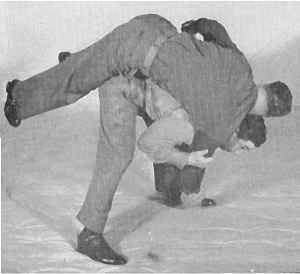
Your opponent will fly over your head, striking the ground on his back.
About the Technical Commentators
Mike Belzer began practicing Kodenkan (Danzan Ryu) jujutsu at age 9, and in 1974, at age 18, he met and trained with Donn F. Draeger and Takaji Shimizu in Japan. In 1979, after returning to the US from a trip to Malaysia with Draeger, he also began studying Filipino kali under Dan Inosanto. Since 1990 he has focused his training on using "adrenal-stress conditioning" in realistic scenarios against heavily padded assailants. He is presently ranked 5-dan in Kodenkan jujutsu and apprentice instructor in kali, and serves as a consultant to the Los Angeles Police Department's Civilian Martial Arts Advisory Panel (CMAAP).
Joseph Svinth is editor of Journal of Non-lethal Combatives.